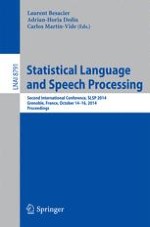2014 | Buch
Statistical Language and Speech Processing
Second International Conference, SLSP 2014, Grenoble, France, October 14-16, 2014, Proceedings
herausgegeben von: Laurent Besacier, Adrian-Horia Dediu, Carlos Martín-Vide
Verlag: Springer International Publishing
Buchreihe : Lecture Notes in Computer Science
